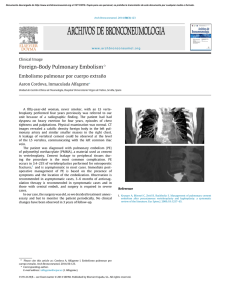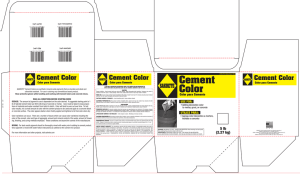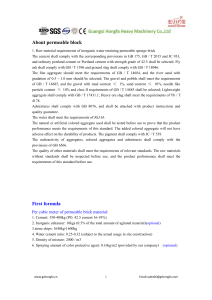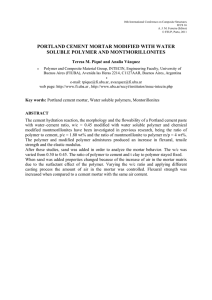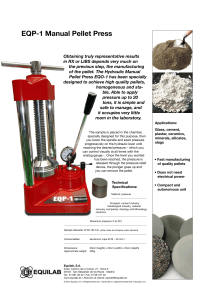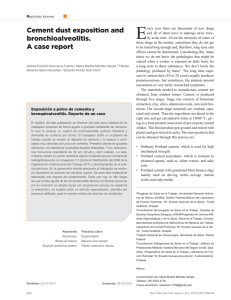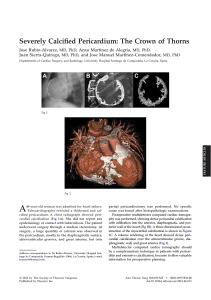Chandra 2002 Influence of cement superplasticizer type and dosage on the parte 2
Anuncio
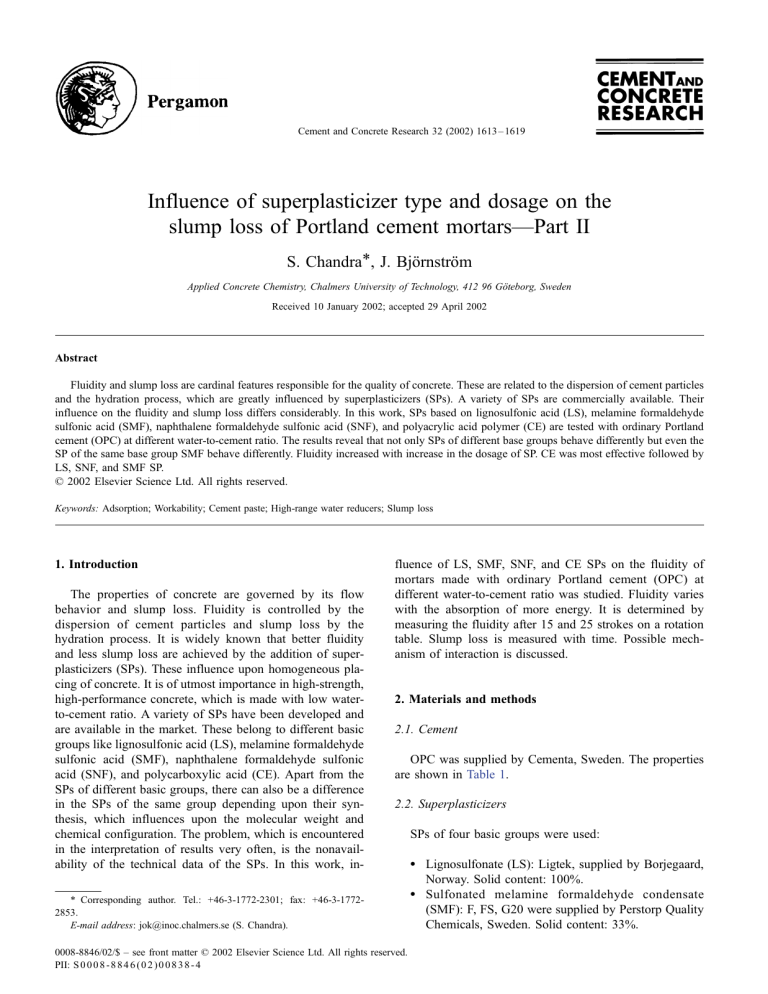
Cement and Concrete Research 32 (2002) 1613 – 1619 Influence of superplasticizer type and dosage on the slump loss of Portland cement mortars—Part II S. Chandra*, J. Björnström Applied Concrete Chemistry, Chalmers University of Technology, 412 96 Göteborg, Sweden Received 10 January 2002; accepted 29 April 2002 Abstract Fluidity and slump loss are cardinal features responsible for the quality of concrete. These are related to the dispersion of cement particles and the hydration process, which are greatly influenced by superplasticizers (SPs). A variety of SPs are commercially available. Their influence on the fluidity and slump loss differs considerably. In this work, SPs based on lignosulfonic acid (LS), melamine formaldehyde sulfonic acid (SMF), naphthalene formaldehyde sulfonic acid (SNF), and polyacrylic acid polymer (CE) are tested with ordinary Portland cement (OPC) at different water-to-cement ratio. The results reveal that not only SPs of different base groups behave differently but even the SP of the same base group SMF behave differently. Fluidity increased with increase in the dosage of SP. CE was most effective followed by LS, SNF, and SMF SP. D 2002 Elsevier Science Ltd. All rights reserved. Keywords: Adsorption; Workability; Cement paste; High-range water reducers; Slump loss 1. Introduction The properties of concrete are governed by its flow behavior and slump loss. Fluidity is controlled by the dispersion of cement particles and slump loss by the hydration process. It is widely known that better fluidity and less slump loss are achieved by the addition of superplasticizers (SPs). These influence upon homogeneous placing of concrete. It is of utmost importance in high-strength, high-performance concrete, which is made with low waterto-cement ratio. A variety of SPs have been developed and are available in the market. These belong to different basic groups like lignosulfonic acid (LS), melamine formaldehyde sulfonic acid (SMF), naphthalene formaldehyde sulfonic acid (SNF), and polycarboxylic acid (CE). Apart from the SPs of different basic groups, there can also be a difference in the SPs of the same group depending upon their synthesis, which influences upon the molecular weight and chemical configuration. The problem, which is encountered in the interpretation of results very often, is the nonavailability of the technical data of the SPs. In this work, in- fluence of LS, SMF, SNF, and CE SPs on the fluidity of mortars made with ordinary Portland cement (OPC) at different water-to-cement ratio was studied. Fluidity varies with the absorption of more energy. It is determined by measuring the fluidity after 15 and 25 strokes on a rotation table. Slump loss is measured with time. Possible mechanism of interaction is discussed. 2. Materials and methods 2.1. Cement OPC was supplied by Cementa, Sweden. The properties are shown in Table 1. 2.2. Superplasticizers * Corresponding author. Tel.: +46-3-1772-2301; fax: +46-3-17722853. E-mail address: [email protected] (S. Chandra). 0008-8846/02/$ – see front matter D 2002 Elsevier Science Ltd. All rights reserved. PII: S 0 0 0 8 - 8 8 4 6 ( 0 2 ) 0 0 8 3 8 - 4 SPs of four basic groups were used: Lignosulfonate (LS): Ligtek, supplied by Borjegaard, Norway. Solid content: 100%. Sulfonated melamine formaldehyde condensate (SMF): F, FS, G20 were supplied by Perstorp Quality Chemicals, Sweden. Solid content: 33%. 1614 S. Chandra, J. Björnström / Cement and Concrete Research 32 (2002) 1613–1619 Table 1 Composition and properties of the cement used; OPC C2S (%) C3S (%) C3A (%) C4AF (%) K2O + Na2O (%) SO3 (%) Specific surface area (m2/kg) Density (kg/m3) 13 64 5 10 1.6 3.2 337 3200 Data presented were supplied by the manufacturer. Sulfonated naphthalene formaldehyde condensate (SNF): Mighty 100, supplied by Kao Chemicals, Japan. Solid content: 100%. Polyacrylic acid polymers (CE): Mapefluid X404, supplied by Mapei, Italy. It is a naphthalene and sulfonate free SP. Solid content: 33%. Standard grade sand 1, 2, 3 was used. The mortars were made with 1:3 cement-to-sand ratio, where equal parts of each sand grade were mixed. Mortars were mixed in a Hobart mixer. Fluidity and fresh density were measured with different dosages of three types of SMF: F, FS, G20; SNF: Mighty 100; and CE: Mapefluid X404 at different water-to-cement ratios, in the same way as in Part I [1]. The dosages of SPs mentioned in this study were calculated to the weight of cement: weight of SP (33 wt.% solution SMF and CE) or in solid form (SNF and LS) to dry weight of cement. Hence, a dosage of 1% of an SP in solution (33 wt.%) is comparable to a dosage of 0.3% of a SP in solid form. Flow area was measured after 15 and 25 strokes. Flow area was also measured after 15, 30, and 45 min of mixing to evaluate the slump loss. Air content was calculated. Flow was measured at 20 °C by pull out spread of the mortar from a cone of top diameter 70 mm, bottom diameter 100 mm and height 60 mm. The spread was the average of two perpendicularly crossing diameters. From the spread ( F), relative flow area (Ã) was calculated by Eq. (1) [2]. Ã ¼ ðF=r0 Þ2 1 measured after 15 strokes. After 25 strokes, some differences could be observed. G20 has shown highest fluidity followed by F and FS. The fresh density with F was low at 0.45 water-to-cement ratio, which is attributed to insufficient wettability, producing inadequate compaction. The fresh density increased with an increase in the water-tocement ratio to 0.50. This showed that this is the optimum water content for producing a well-compacted mortar. Further increase in the water-to-cement ratio resulted in a decrease in density due to a decrease of the solid material. For the other two SMF, the fresh density decreased with an increase in the water-to-cement ratio. This shows that these SMF give optimum wettability for producing well-compacted mortar. Thence, further increase in water-to-cement ratio resulted in a gradual decrease of density. The air content decreased with respect to increase in the water-tocement ratio (Fig. 1d). Increase in the dose of SMF to 2% resulted in an increase in the fluidity at all water-to-cement ratios, but the effect was most significant with G20. F and FS did not show much difference with increase in dosage. An increase in the number of strokes to 25 increased the fluidity, but the trend was the same (Fig. 2a– b). Even though the addition of the SP G20 resulted in a significant fluidity, the fresh density of the mortars was high at 0.45 water-to-cement ratio. An increased water-to-cement ratio gave a decrease in fresh density (Fig. 2c). The fresh density measured for mortars containing F and FS was less dependent on the water-tocement ratio (Fig. 2c). The air content was higher for F and ð1Þ where r0 = 50 mm, bottom cone radius. Flow area and fresh density data presented are based on triplicate measurements. The average standard deviation using the abovementioned method determining flow area is 1.12 and for the fresh density determinations, 5.88. The results are shown in Figs. 1– 7. 3. Results and discussions Figs. 1a –d and 2a– d show the results for 1% SMF and 2% SMF, respectively. It is seen in Fig. 1a –b that F and FS were not as effective as G20 in improving the fluidity. There was no difference between F and FS when the flow was Fig. 1. Flow area after 15 strokes (a), flow area after 25 strokes (b), fresh density (c), and air content (d) with respect to the water-to-cement ratio for different SMF SPs (1%): F, FS, and G20. OPC was used. S. Chandra, J. Björnström / Cement and Concrete Research 32 (2002) 1613–1619 Fig. 2. Flow area after 15 strokes (a), flow area after 25 strokes (b), fresh density (c), and air content (d) with respect to the water-to-cement ratio for different SMF SPs (2%): F, FS, and G20. OPC was used. FS compared to G20 for all water-to-cement ratios (Fig. 2d). The observed differences in the behavior of the SPs are attributed to the difference in their synthesis, which can influence upon their molecular weight and chemical con- Fig. 3. Flow area after 15 strokes (a), flow area after 25 strokes (b), fresh density (c), and air content (d) with respect to the water-to-cement ratio for different SPs: SNF (0.5%), LS (0.3%), and CE (1%). OPC was used. 1615 Fig. 4. Flow area after 15 strokes (a), flow area after 25 strokes (b), fresh density (c), and air content (d) with respect to the water-to-cement ratio for different SPs: SNF (1%), LS (0.4%), and CE (2%). OPC was used. figuration. Apart from this, the amount of unreacted monomer, which is not polymerized, can also vary. It can have considerable influence upon the hydration process of cement. However, in the absence of technical data one can only speculate about the chemical differences. This is an issue that needs to be carefully investigated. Figs. 3 and 4 show the fluidity, fresh density, and air content of mortar samples with SPs SNF, LS, and CE. It is clearly seen that the fluidity significantly increased with the addition of CE. The weakest effect was observed for SNF. It seems that 0.5% SNF is too little to influence the fluidity (Fig. 3a). An increase in the work applied on the samples (25 strokes instead of 15) gives an increase in the fluidity but is in the same order of magnitude (Fig. 3b). The fresh density was highest with SNF and lowest with LS (Fig. 3c). The air content was very high with LS and lowest with SNF (Fig. 3d). It is in accordance with the density. Fig. 4a and b shows that an increase in the dose of SP significantly increased the fluidity specifically for SNF. The influence of the dose increase was very small for CE. However, this SP still gave the highest fluidity (Fig. 4a and b). Increase in the strokes increased the fluidity at all water-to-cement ratios (Fig. 4b). It is noteworthy to see that in spite of a high fluidity, CE has shown very high density and has maintained it even at high water-to-cement ratios. This may be due to the formation of complexes consuming water and not giving dilution effect decreasing the solid content in the mass as in the case with other SPs. The density with SNF and LS decreased with an increase in the water-to-cement ratio (Fig. 4c). The air content decreased 1616 S. Chandra, J. Björnström / Cement and Concrete Research 32 (2002) 1613–1619 with an increase in the density for CE-containing samples. At 0.55 water-to-cement ratio, there was practically no air left in the mortar. The air content in SNF mortars was almost constant at all water-to-cement ratios. With mortar containing LS it decreased and then increased again (Fig. 4d). The fluidity decreases with time after mixing of the mortars. This decrease in the fluidity is named slump loss. The loss in fluidity was measured up to 45 min after mixing. Fig. 5a– b shows that the fluidity decreased with time. This effect was more pronounced for G20. The slump loss was larger when measured after 25 strokes. The densities also decreased with time except in the case of F where it increased (Fig. 5c). The air content increased with time for G20 and FS. In the case of F, it decreased (Fig. 5d). The decrease in density can be attributed to inadequate packing due to stiffening of the mortar with the progress of hydration. The slump loss was higher with SNF compared with LS, whereas the CE-containing mortars maintained a high fluidity and there was no appreciable loss after 60 min (Fig. 6a). After 25 strokes, the slump loss was more pronounced but the trend was the same as after 15 strokes (Fig. 6b). The fresh density increased with time up to 30 min and then decreased for SNF and LS. It may be because the mortar started becoming stiff, thereby causing inadequate packing of the mass in the pot for measuring density. In the case of CE, the density decreased (Fig. 6c). The air content decreased with the increase in densities for LS and SNF but in the case of CE, it increased all the time (Fig. 6d). With an increase in the dosage, LS and CE have not shown appreciable slump loss, whereas some slump loss Fig. 5. Slump loss. Flow area after 15 strokes (a), flow area after 25 strokes (b), fresh density (c), and air content (d) with respect to time for different SMF SPs (1%): F, FS, and G20. OPC was used. Fig. 6. Slump loss. Flow area after 15 strokes (a), flow area after 25 strokes (b), fresh density (c), and air content (d) with respect to time for different SPs: SNF (0.5%), LS (0.3%), and CE (0.5%). OPC was used. was seen with SNF (Fig. 7a). This effect is more pronounced when measured after 25 strokes. Nevertheless, the trend is the same as after 15 strokes (Fig. 7b). The fresh Fig. 7. Slump loss. Flow area after 15 strokes (a), flow area after 25 strokes (b), fresh density (c), and air content (d) with respect to time for different SPs: SNF (1%), LS (0.4%), and CE (1%). OPC was used. S. Chandra, J. Björnström / Cement and Concrete Research 32 (2002) 1613–1619 density of samples containing LS was low up to 30 min (Fig. 7c). The increase in density shown in Fig. 7c is due to the fact that the amount of air entrained in the mortar decreased with time. The fresh density of CE and SNF did not change much up to 60 min. There was no appreciable difference in the air content with time for CE and SNF, but in the case of LS, it decreased with time (Fig. 7d). 3.1. Slump loss Slump loss involves chemical and physical processes. The loss of consistency in the cement paste during the dormant stage is mainly attributed to the physical coagulation of cement particles rather than to chemical processes. In the period during which the slump loss is occurring, the tricalcium aluminate reacts with gypsum. The product develops into a crystalline structure and is distributed in the mass. There is some evidence that concretes made with cements having moderate to high C3A contents (C3A = 9.0%) show increased slump loss over that of control concrete [3]. The contrary appears to be true for concrete made with cements having a low C3A content. However, the use of low C3A cement is no guarantee that the slump loss will be reduced. Mailvagnum [4] has shown slightly lower rates of slump loss for ASTM type V cements (C3A = 2.6%) than for ASTM type I cements having C3A content 6.9 – 12.6%. These results indicate that slump loss is related to the relatively large adsorption of SP by aluminate phases. SO3 content, alkali content, and C-S-H bridge formation are considered to be the main factors influencing slump loss. It has generally been found that the fluidity increases with SO3 content. There is a competition between SO42 ions and SPs for adsorption on the cement particles. As a consequence, the solution phase will have a larger amount of admixture [5]. Higher amounts of alkalis were found to lower the flow values because alkalis accelerate the hydration of cement. Another explanation for the above flow loss concerns the enhancement of C-S-H bridges formation between the granules at high ionic strength. It occurs during the hydration of C3S. This process is influenced by the C3S/ C2S ratio and the mean distance between the particles, which depends on the fineness and particle size of cement as well as on the water-to-cement ratio [6]. Alternately, the slump loss may be related to the chemical properties of the fluid paste. It may be predicted that the negatively charged surfaces of the cement particles are more affected by a strong electrolyte in the pore solution rather than a weaker one. High ionic strength pore solution will induce a greater polarization of the double surface layer formed around the particles and this in turn would probably generate more electrostatic bonds that reduce the fluidity. Bonen and Sarkar [7] have the opinion that the slump loss is closely related to the chemistry of pore solution rather than the C3A content. This suggests therefore that flow loss is related to the C3S hydration, but neither to ettringite formation nor to secondary ettringite crystallization, which 1617 may form a three-dimensional network comprising large ettringite needles that arrest fluidity [8]. Fluidity would then be related more to the C3S/C2S ratio. A higher ratio would give a higher fluidity. 3.2. Influence of alkali content In the absence of SP, cements containing high levels of alkali (e.g., Na2SO4 or K2SO4) will usually exhibit poorer rheological behavior than cements having low alkali contents, other conditions being the same. Also, the water reduction with admixtures will be more readily achieved with low alkali cement [9]. Several effects may be promoted by the alkalis, namely, flocculation of cement (or other) fine particles induced by the electrolytes, formation of new hydrates containing alkali ions (e.g., syngenite), and increase in the reactivity of mineral phases (particularly C3A). In the presence of SP, it has been observed that the addition of alkali sulfates (Na2SO4) can lead to improvements in the rheological properties of cement paste [10,11]. While the results shown may not be generalized, they are consistent with the concepts of SO42 /SP competition. The presence of SO42 ions leads to a decreased absorption of the SP, leaving more of the latter available on the solution phase for paste fluidification; the fluidity of the paste increases, accordingly, with the amount of Na2SO4 added. In another study, Andersson et al. [11] further reported that the adsorption of SP was reverted by addition of potassium hydroxide (KOH). 3.3. Influence of water-to-cement ratio The water-to-cement ratio controls the concentration of ions in the pore solution. At a low water-to-cement ratio, the surface of interstitial phases especially of C3A and C4AF is covered by the adsorbed SP, thus very little SP is in the pore solution. But with an increase in the water-to-cement ratio, more alite hydrates and thereby more Ca2 + ions are produced. Lime saturation in the pore solution increases, poisoning the hydration process. Subsequently, the fluidity increases. It has been observed in the experiments that at a water-to-cement ratio of 0.45 there was no significant increase in fluidity, but when it exceeded 0.45, there was a substantial increase in fluidity (Figs. 3 and 4). 3.4. Fresh density and air content The SP type LS has the tendency of entraining air because of the surface active agents, tensoids, used in the production process. This is confirmed in the experimental results (Figs. 3d, 6d, and 7d). 3.5. Influence of SP Before discussing the influence of SP, it is necessary to define fluidity and slump loss. 1618 S. Chandra, J. Björnström / Cement and Concrete Research 32 (2002) 1613–1619 3.5.1. Fluidity The fluidity of the mortar is defined as the consistency of the paste immediately after mixing cement, water, and SP. This implies that the fluidity will be influenced by the immediate adsorption of SP on the cement particles. Fluidity is measured as the flow area at a certain energy input and a certain time (see Materials and methods). 3.5.2. Slump loss Slump loss is defined as the decrease in fluidity with time. This implies that slump loss is influenced by the hydration process of the cement. Acceleration in the hydration process will increase slump loss, whereas a retardation in the hydration process will decrease slump loss. It is reported that the degree of hydration of C3S and C3A in the presence of SMF is retarded [12]. This retardation effect differs with the type of SMF. This influences upon fluidity and slump loss. In the present work, it is shown that the SMF F was not as effective as the FS and G20 types. It means that the hydration process continued in the same order, with the lowest effect by the addition of F and the highest effect by the addition of G20. This was confirmed by determining the CH and C-S-H content after particular intervals. The determination was accomplished by thermal gravimetric analyses. The results show that the amount of CH present is lower with the addition of F than with FS and G20. The difference in reactivity is expected to be due to the difference in molecular weight and chemical configuration of the SPs. However, since the SPs are commercial products, data were not available. Anyhow, the results obtained show that SPs of the same family may behave differently with the same cement. The lowest fluidity was measured for mortars with 0.5% SNF compared to those with LS and CE. The highest fluidity was observed after the addition of CE. An increase in the SNF dose to 1.0% increased the fluidity, however, it was still lower than with LS. This showed that the amount of SNF addition was too low to have some effect on fluidity. As mentioned earlier, slump loss is related to the degree of hydration, which varies with different SPs and their dosage. The hydration of the interstitial phases occurs mainly during the first hour just after mixing with water. This hydration is affected by the concentration of Ca2 +, OH , and SO3 in the mixing water. The concentration of these ions depends upon the hydration reaction of alite. The hydration of the interstitial phase is affected in particular by the lime saturation ratio, which varies with time. In a study, it was shown that the variation over time of the lime saturation ratio when using lignine sulfonic acidbased admixture is smaller than in the case using melamine or naphthalene sulfonic acid-based admixtures. The reason is that lignine sulfonic acid-based admixture takes up Ca2 + from the mixing water [13]. This is in agreement with the experimental results reported here, i.e., slump loss is lower for mortars with LS than for those with SMF or SNF, since more LS remains in the solution. Carboxylic acid-based admixture (CE) produces high fluidity and maintains this fluidity for some time, i.e., slump loss is very low. The mechanism of interaction for CE is different than for sulfonic acid-based admixtures. The sulfonic acid-based admixtures are anionic surface active admixtures. Accordingly, these are adsorbed on the cement particles, which are then provided with a negative surface potential in water. Cement particles with negative potential are electrostatically repelled by each other. Polycarboxylic acid-based admixtures are nonionic surface active compounds. The side chains of polyethylene oxide extending on the surface of cement particles migrate in water and the cement particles are dispersed by the stearic hindrance of the side chains. 3.6. Influence of strokes The results show that fluidity increased when measured after 25 strokes compared to 15 strokes. When the number of strokes is increased, higher energy is introduced in the cement paste, resulting in a decrease in viscosity, which indicates that the cement paste has a thixotropic character. The yield stress is reduced and the flow behavior tilts towards Newtonian. 4. Conclusions The results reveal that not only SPs with different basic groups behave differently, but even the SP of the same basic group (SMF) behaves differently. This is attributed to the difference in their synthesis, which influences upon their molecular weight and chemical configuration. Fluidity increased with an increase in the dosage of SP. Fluidity and slump loss varied with the type of SP. Increase in fluidity of the cement mortar is due to adsorption of the SP on cement particles, which hinders the hydration process. Slump loss is due to the resumption of the hydration process. Carboxylic acid-based SP was most effective improving the flow characteristics of cement mortars followed by LS, naphthalene sulfonic acid, and melamine sulfonic acidbased SP. Many factors are influencing the fluidity and hydration process of the cement paste. Some of these factors may also have synergistic effects. This makes a theory based on one parameter irrelevant, and it makes it difficult to point out one parameter, which is responsible to produce a particular property. Acknowledgments This work has received financial support from The Knowledge Foundation (KK-stiftelsen, Stockholm), which is gratefully acknowledged. S. Chandra, J. Björnström / Cement and Concrete Research 32 (2002) 1613–1619 References [1] S. Chandra, J. Björnström, Influence of cement and superplasticizer type and dosage on the fluidity of cement mortars—Part I, 2002, in press. [2] H. Okamura, K. Ozawa, S. Matsuo, K. Shimokawa, Evaluation of superplasticizers for self compacting concrete with mortar test, JCA Proc. Cem. Concr. 48 (1994) 374 – 379. [3] W.F. Perenchio, D.A. Whiting, D.L. Kantro, Water reduction, slump loss and entrained air void systems, in: V.M. Malhotra (Ed.), ACI SP 62, 1979, pp. 137 – 156. [4] N.P. Mailvagnum, Slump loss in flowing concrete, in: V.M. Malhotra (Ed.), ACI SP 62, 1979, pp. 389 – 404. [5] K. Hattori, Experience with mighty superplasticizer in Japan, in: V.M. Malhotra (Ed.), ACI SP 62, 1979, pp. 37 – 66. [6] J.P. Bombled, O. Kalvenes, Comportement rheologique des pates, mortiers et betons: Mesure, evolution, influence de certains parametre, Rev. Mater. Constr. 617 (1967) 39 – 52. [7] D. Bonen, S.L. Sarkar, The superplasticizer adsorption capacity of 1619 cement pastes, pore solution composition, and parameters affecting flow loss, Cem. Concr. Res. 25 (7) (1995) 1423 – 1434. [8] Y. Chen, I. Odler, On the origin of Portland-cement setting, Cem. Concr. Res. 22 (6) (1992) 1130 – 1140. [9] V. Dodson, Concrete Admixtures, Van Nostrand-Reinhold, New York, 1990. [10] T. Nawa, H. Eguchi, Y. Fukaya, Effects of alkali sulfates on the rheological behavior of cement pastes containing superplasticizers, in: V.M. Malhotra (Ed.), Superplasticizers and other chemical admixtures in concrete, Proc. 4th CANMET/ACI Int Conf. ACI SP 119, 1989, pp. 405 – 424. [11] P.J. Andersson, A. Kumar, D.M. Roy, D. Wolfe-Confer, The effects of calcium sulphate concentration on the adsorption of a superplasticizer on a cement; Methods, Zeta potential and adsorption studies, Cem. Concr. Res. 16 (1986) 255 – 259. [12] I. Odler, S. Abdulmaula, Effects of chemical admixtures on cement hydration, Cem. Concr. Aggregates 9 (1987) 38 – 43. [13] H. Uchikawa, K. Ogawa, S. Uchida, Effects of admixtures on the rheology of fly ash cements, JCA Proc. Cem. Concr. 37 (1983) 53 – 56.


